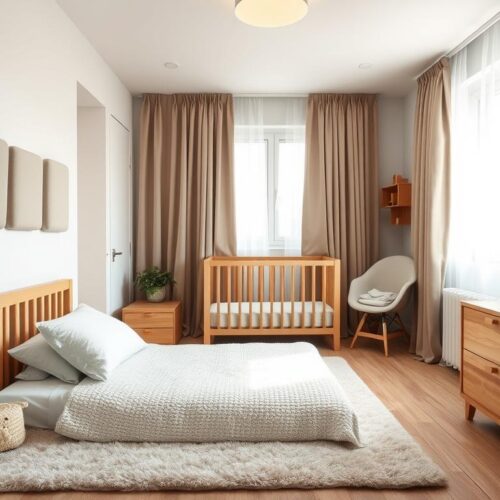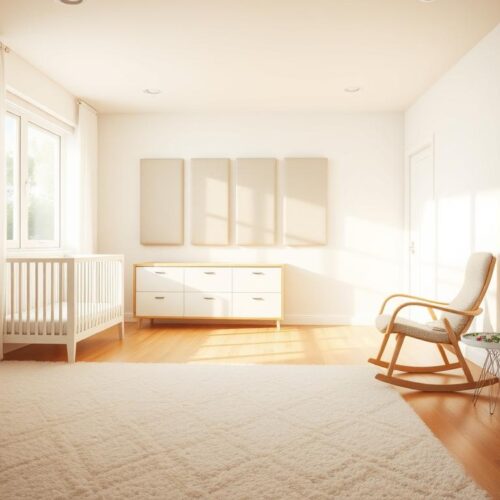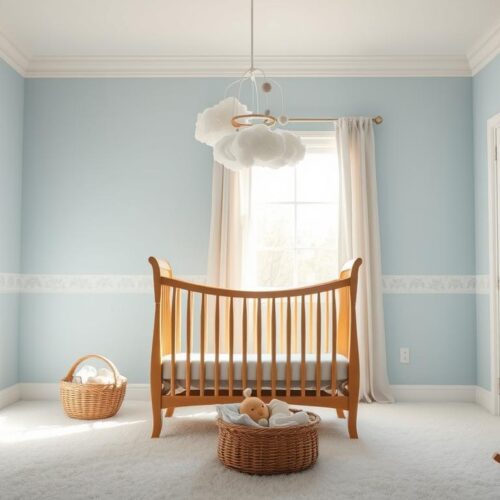Being a parent means facing the challenge of getting your baby to sleep with noise around. White noise can be a great help. It makes a calming environment for your baby to sleep easily.
Knowing when and how to use white noise for your baby is key to better sleep. You can use a white noise machine or a baby app. These tools help make a peaceful sound background at bedtime.
What is White Noise?
White noise combines all sound frequencies at the same volume, creating a steady hum. It sounds like the static from a radio or TV that’s not tuned. For many, it’s a way to help newborns sleep peacefully and without interruption.
Studies show that the best white noise for babies sounds like the womb. It includes heartbeats or soft sounds from nature. These are favorites among parents. White noise helps babies by blocking out sudden sounds, so they sleep more soundly and for longer periods.
Understanding the Benefits of White Noise for Babies
Using white noise helps your baby sleep better. It acts as a soothing background. It hides loud, sudden sounds, making a calm place for sleep. Families with more than one child find white noise machines useful. They keep noises like talking and outside sounds from waking the baby.
Research shows babies fall asleep faster with white noise. It reminds them of the quiet, secure feeling of being in the womb. So, your baby can sleep better and longer, feeling calm and safe.
How Does White Noise Work for Babies?
White noise helps babies sleep well by blocking sudden noises. This sound keeps sleeping environments calm. It lets your baby fall asleep without getting woken up.
White noise sounds like what babies hear in the womb. This sound makes the outside world feel less scary. Parents use white noise machines with lullabies or heartbeat sounds. It makes babies feel safe at night.
Using white noise with bedtime routines improves sleep. It blends with your baby’s sleep patterns. This mix makes bedtime peaceful for your baby and your home.
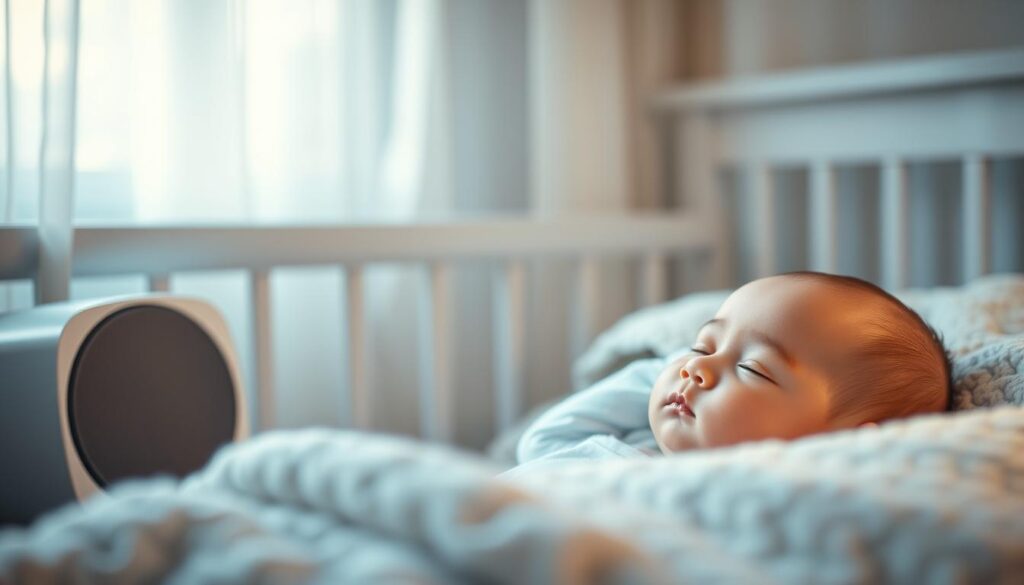
When to Start Using White Noise for Your Baby
You can start using white noise for your newborn within the first few weeks. It helps your baby get used to different sleeping spots successfully. Newborns often like sounds that remind them of being inside the womb. So, white noise works well to make them sleep better.
Be careful when you begin with white noise. Keep the sound low to avoid hurting your baby’s ears. Also, make sure the noise machine isn’t too close to the crib. This keeps your baby’s sleep area calm and safe.
Creating a regular bedtime routine with white noise is a good idea. It lets your baby know it’s time to rest. This habit builds strong sleep patterns, helping both you and your child. As a parent, it’s key to watch for your baby’s needs to use white noise right.
White Noise for Babies: Pros and Cons
White noise for babies has its ups and downs that parents need to think about. Knowing the good and bad points of white noise can help you choose wisely for your baby’s sleep routine.
On one hand, many parents find that white noise helps their babies sleep better and longer. It makes a steady sound that gives babies comfort, making them feel calm and snug. It also drowns out other noises, which is great in loud places or busy homes.
However, there are some downsides to consider. A big worry is that babies might get too used to the sound and have trouble sleeping without it. Plus, if the noise is too loud, it could hurt their ears. So, it’s important to use white noise carefully.
Here’s a summary of the pros and cons of white noise for babies:
| Pros | Cons |
|---|---|
| Improves sleep onset and duration | Dependency on the sound machine |
| Creates a comforting sound environment | Potential hearing issues with loud volumes |
| Masks environmental noise | May interfere with natural sleep cues |
Choosing the Right White Noise Machine
When picking the perfect white noise machine for your baby, consider a few key points. Look for models with various sound options. This lets you find the best white noise to suit your child’s likes. It’s essential to choose machines that can run continuously without timers. This keeps the sleeping area calm.
It’s also important to check the volume control. Find a white noise machine that lets you adjust the sound. Make sure it doesn’t go over 50 decibels to keep your baby’s ears safe. Avoid machines with bright lights as they can disturb sleep. Choose ones with minimal or no lights.
Consider how easy it is to take the machine with you if you travel often. Brands like Marpac and Hatch have dependable machines that are travel-friendly. Picking a machine from a well-known brand helps ensure it fits your family’s needs.
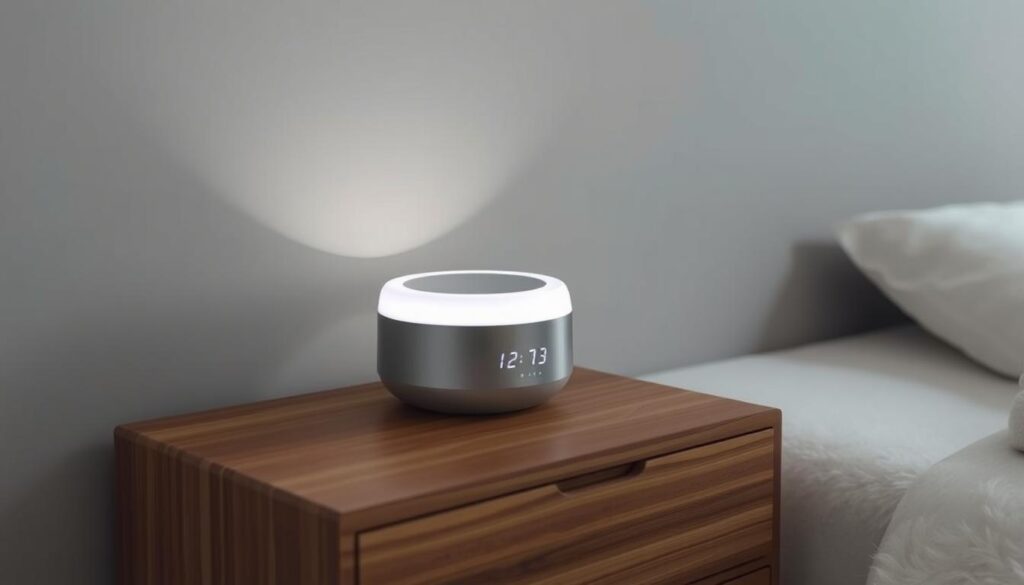
| Brand | Sound Options | Volume Control | Portability |
|---|---|---|---|
| Marpac Dohm | Natural fan sounds | Two-speed settings | Compact for travel |
| Hatch Baby Rest | White noise, nature sounds | Adjustable via app | Portable and lightweight |
| LectroFan | Fan sounds, white noise | 10 volume levels | Travel-friendly design |
| Homestar Classic | Natural sounds | Single volume setting | Stable and durable |
Safe Use of White Noise for Babies
To use white noise safely for your baby, follow certain rules. The American Academy of Pediatrics suggests keeping the noise machine more than 7 feet from the crib. This helps make sure the sound is not too loud for your baby.
Keeping the volume low is important. Experts say to keep noise below 50 decibels to protect hearing. It’s a good idea to check the noise level often.
Watching how your baby reacts to white noise is key. If they seem upset, turn off the noise right away. The aim is to make sleeping calm and soothing. Paying attention to what your baby needs is crucial.
| Safety Guidelines | Recommendations |
|---|---|
| Distance from Crib | At least 7 feet |
| Volume Level | Below 50 decibels |
| Monitor Reactions | Check for distress |
| Regular Assessment | Check noise output often |
By following these tips, you can safely use white noise. This can help your baby sleep better.
Transitioning Away from White Noise
Weaning off white noise takes time and can make sleep easier for your baby without those familiar sounds. Start by slowly turning down the volume of the white noise machine over a few days. This careful method lets your baby get used to the change without messing up their sleep.
When you think your baby can handle it, use white noise only at night, not during daytime naps. This way, they get the comfort they need for the longer night sleep while learning to nap without noise during the day. You may notice that your baby sleeps better with white noise at night but can do without it during the day.
Be patient with this change. Some babies may need more time to get used to silence. A steady bedtime routine can help calm your baby and make this transition smoother. Paying close attention to their needs shows you care and support them through this change.
Watch how your baby reacts to these changes, as they might need extra comfort. If they start waking up more, they might need more support from you. With time, getting your baby to sleep without white noise is possible, leading to independent sleeping habits.
| Phase | Action | Duration |
|---|---|---|
| Initial Adjustment | Start reducing volume | 3-5 days |
| Day Sleep Limit | No white noise during naps | 1-2 weeks |
| Nighttime Gradual Weaning | Reduce reliance at night | 2-4 weeks |
| Complete Transition | No white noise used | 4-8 weeks |
Alternatives to White Noise
If you’re searching for good alternatives to white noise, there are several. They can make sleep time for your baby very calming. You can use ambient sounds. Think lullabies or nature sounds like soft rain or leaves moving in the wind. These sounds help your baby relax without the white noise machines’ buzz.
Trying out soft classical music is another smooth move. It sets up a calm vibe, helping your baby to snooze easier. Also, things around your house like fans or recordings of the sea waves offer a steady soothing sound. They work well for babies and skip the mechanical sound from machines.
| Sound Type | Description | Benefits |
|---|---|---|
| Lullabies | Soft, melodic tunes sung or played for relaxation | Creates a familiar, comforting atmosphere |
| Nature Sounds | Ambient sounds of rain, wind, or animal noises | Promotes a peaceful sleep environment |
| Classical Music | Soothing instrumental pieces | Encourages calmness and restful sleep |
| Fan Noise | White noise created by the circulation of air | Simple, easily accessible, and effective |
| Ocean Waves | Recording of waves gently crashing on the shore | Relaxing sound reminiscent of bedtime at the beach |
Expert Recommendations and Guidelines
Experts, like pediatricians, stress the careful use of white noise. It’s key to follow guidelines to keep babies safe and comfortable. They advise keeping the sound low, about 50 decibels, to protect hearing. Also, the noise machine should not be too close to the crib.
It’s good to start cutting down on white noise as your baby gets used to it. Lowering it over time teaches them to sleep without it. This builds strong sleep routines. Talking to a pediatrician can offer more help, especially for sensitive babies or those with sleep issues.
Conclusion
White noise can make a big difference for babies’ sleep. It creates a calming space by copying the womb’s sounds. This makes your baby feel safe and calm. But, it’s important to use white noise the right way and watch how your baby reacts to it.
Since every baby is different, you might need to change the white noise volume or how long it plays. Finding the best way to make your baby’s sleep space cozy is crucial. With what you’ve learned here, you can start using white noise to help your baby sleep better.
Remember, knowing what to do and being able to change your approach are key. With the right steps, you can improve your baby’s sleep. This leads to peaceful nights for everyone in the family.


